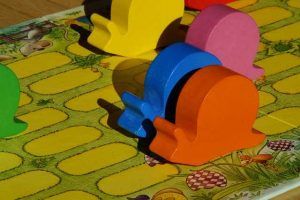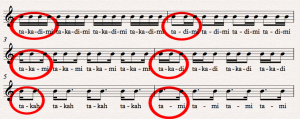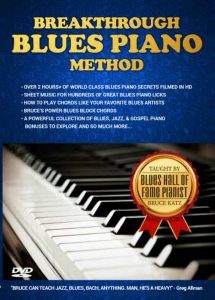Five Metronome Exercises For Developing Killer Jazz Rhythm
 Metronome exercises are a surefire way to get your jazz rhythm chops to groove on the piano.
Metronome exercises are a surefire way to get your jazz rhythm chops to groove on the piano.
Today’s lesson will take you from having zero rhythmic sensibility to a total groove machine!
These five metronome exercises are designed to make the most out of your metronome and improve your sense of time.
By being able to play in the pocket, your playing will be solid, you and your fellow musicians will surely sound good, your audience will be moved by your groove, and everybody will have fun.
Playing in the groove is especially important for jazz pianists like you because you will do everything from comping to soloing.
Everything great in music always falls in the pocket, so you better grab that timekeeping device and get started with these metronome exercises.
1. What’s the Best Way to Build Speed with Metronome Exercises?
 Do you wonder how legendary jazz piano players blaze their way through the keyboard in perfect timing but you can’t?
Do you wonder how legendary jazz piano players blaze their way through the keyboard in perfect timing but you can’t?
How are they different from you anyway?
Guess what: it’s all about how they practice. Try the most fundamental method that legends use:
Whenever you’re trying to learn a new lick, you have to practice it real slow.
What’s the reason why you should do it that way? This is because practicing slow incorporates movements into muscle memory very well.
When done correctly, slow practice will turn what you’re learning into something that’s second nature to you.
That’s right. You won’t even have to think about that fancy lick. You’ll just be able to play it as easy as you would brush your teeth or comb your hair!
The next question is how slow is slow? The tempo should be slow enough for you to succeed playing a passage of music without making a mistake.
The world’s best musicians such as Itzhak Perlman, John Petrucci, and Sergei Rachmaninoff swear by it!
 How do you do slow practice correctly? Here’s what you do:
How do you do slow practice correctly? Here’s what you do:
- Figure out what the shortest and consistent rhythmic unit is in the music you are working on. Is it an 8th note? A 16th? It really depends on what you are working on.
- Once you’ve figured that one out, each tick of the metronome will now be that short rhythmic unit. For example, if you’re working on a lick with 16th notes, each metronome tick is equal to a 16th note.
- Make sure that you are using consistent fingering while practicing.
Remember this: Prioritize accuracy over speed!
This first exercise works really well with pinning down tricky passages and dealing with really fast tempos.
Once correct movements are locked into muscle memory by practicing slow with a metronome, learning how to play it fast becomes easy.
For more tips, check out this lesson on how to deal with fast tempos.
2. Learn Some Swing Metronome Exercises
 A big part of jazz involves knowing how to swing.
A big part of jazz involves knowing how to swing.
You must learn how to play a really grooving swing feel if you want to feel good, sound good, and have fun with your piano playing.
The swing feel is typically based on a triplet 8th note feel. When playing a pair of 8th notes occupying a beat, the first 8th note sounds longer than the second one. This is swing feel.
So, what’s a precise way of practicing this? Use the metronome this way:
- Consider each beat of a metronome to be a triplet 8th note.
- Using this logic, whenever you see a bunch of 8th note pairs during practice, the first 8th note of a pair receives two metronome ticks and the second one receives just one tick.
To get more detail into getting that swing groove on, learn how to make your jazz melodies swing more.
Speaking of something that really swings, it has to be the Blues.
Learning the blues also reinforces that sense of swing and builds up a more solid foundation for your jazz.
There’s no better way to learn the blues than through a bonafide blues legend like Bruce Katz.
The great news is that you can get that solid blues training with the Breakthrough Blues Method.
As Sir Duke Ellington once said, “It don’t mean a thing if it ain’t got that swing,” so better get your swing feel on!
3. Get The Hang of 16th-Note Rhythms with the Metronome and “TaKaDiMi”
 Faster rhythms can get very tricky, especially 16th-note groupings.
Faster rhythms can get very tricky, especially 16th-note groupings.
With proper practice technique, however, you can tackle such rhythms fine.
To deal with these pesky 16th-note rhythms, you can try metronome exercises that incorporates some techniques from a South Indian vocal percussion tradition called “Konnakol”.
Why incorporate Konnakol with the metronome? Konnakol happens to be one of the most effective ways of rhythmic training, having centuries of effectiveness behind it.
If you can handle fast rhythms in this manner, you’ll have more confidence and a lot more precise, especially when playing fast!
Training this way will help you nail those tricky fast rhythms in no time at all!
 Here’s a Konnakol-inspired way you can tame these groupings and be able to play them with confidence.
Here’s a Konnakol-inspired way you can tame these groupings and be able to play them with confidence.
Are you ready?
Here are the steps:
- First thing to do is consider each metronome tick as a 16th note. In one measure of 4/4, this means that you’ll have 16 metronome ticks.
- 16th notes are typically organized in groups of four. We use these four syllables from Konnakol to represent each 16th note in a group like this: First 16th note in a group is “Ta”, second 16th note is “Ka”, third one is “Di”, fourth one is “Mi”
- Start your metronome and work on your 16th-note passages, considering each tick as a 16th note. While practicing, recite the Konnakol syllables in perfect sync with the metronome and the piano.
- Take note here that whenever you recite these syllables, you can omit some of them if the rhythm of the piece you are working on calls for it. Take a look at sheet music below:

In the sheet music above, whenever a 16th-note grouping has a rhythm like one 8th note and two 16th notes, you will recite “Ta – di – mi” with “ta” having 2 metronome ticks, “di” with 1 tick, and “mi” with 1 tick.
Let’s say we have in that four 16th note grouping a sequence of one 16th note in the beginning, an 8th note in the middle, and then one 16th at the end.
In this case, you will recite “Ta-ka-mi” with “ta” receiving 1 metronome tick, “ka” 2 metronome ticks, and “mi” with 1 metronome tick.
Practice your 16th notes this way and you’ll get impressive accuracy when dealing with such short rhythms.
4. Use Traditional 2-&-4 Jazz Metronome Exercises
 Now is the time for you to get into something that takes into account the bigger picture: the traditional 2-&-4 Jazz Metronome Method.
Now is the time for you to get into something that takes into account the bigger picture: the traditional 2-&-4 Jazz Metronome Method.
If your goal is to learn how to play jazz piano, you got to have that real jazz feel. This way, you’ll sound authentic, the audience will love you for it, and you’ll built deep musical confidence.
The traditional way of doing metronome exercises in jazz is this: each tick of the metronome is equivalent to the 2 and 4 of a 4/4 measure.
By considering each tick as a 2 and 4, you are actually simulating how a jazz drummer plays the hi-hat in a typical jazz groove.
When you work on one of your jazz tunes, the traditional 2-&-4 jazz metronome exercises provide a way for you to work on actual jazz feel.
It also makes you practice keeping time by yourself rather than relying on the metronome like a crutch. This is because you have to count the 1s and 3s yourself to keep track of where the beats are.
Once you got that real jazz feel down, it’s time to bring your jazz game to a new level.
How about some straight Latin rhythms? They’re part of jazz too, you know!
 It’s a different kind of groove, but it’s very lively and you’ll have a great time with your music when you master it.
It’s a different kind of groove, but it’s very lively and you’ll have a great time with your music when you master it.
If you’re wondering where to start learning, why not go learn from a master like David Garfield?
To get that Latin upgrade for your improvisation chops, the Jazz Improvisation Super System is what you need.
Not only will you get some awesome Latin chops from David, you’ll also learn secret improvisation techniques used by the masters.
5. Try Out the Rhythmic Displacement Metronome Method
 Practicing using the rhythmic displacement method involves considering each metronome tick as something other than quarter notes, eighth notes, or any other even rhythm values.
Practicing using the rhythmic displacement method involves considering each metronome tick as something other than quarter notes, eighth notes, or any other even rhythm values.
There are many ways of doing rhythmic displacement metronome exercises, but in this lesson we will feature just one.
For this exercise, consider each metronome tick as a dotted quarter note. Check the chart below:

Now let’s say, you want to practice at 80 BPM. Here’s what you’ll do:
- First, set your metronome at 80 BPM. Practice counting and then clapping or tapping your foot to each beat to get the sense of tempo you need to be at.
- The next step is to set your metronome at a speed thats 25% slower than 80. In this case, set your metronome at 60 BPM.
- Once this is set, start practicing any passage of music or even a tune, keeping time by yourself at 80 BPM but the metronome ticking at 60 BPM.
 As you might rightly conclude, this is perhaps the most difficult exercise in the bunch.
As you might rightly conclude, this is perhaps the most difficult exercise in the bunch.
This follows a similar reason as the traditional 2-&-4 method in that you are forced to keep time while responding to another rhythm.
This rhythmic displacement method simulates the way you play with other musicians where different rhythms will be used but the timing still needs to be spot on.
For example, you can even practice your jazz scales with the metronome on 2-&-4 as well.
If you can pull this exercise off, the way you groove and have fun with other musicians will vastly improve. We’ve only just begun your exploration of jazz exercises. Now what’s next?
The Thing That’s Missing
 Metronome exercises are great and all. However, a metronome is still a machine. It doesn’t groove like a real musician would.
Metronome exercises are great and all. However, a metronome is still a machine. It doesn’t groove like a real musician would.
Don’t get me wrong. I use a metronome, and it has helped a lot improve my rhythmic sensibilities.
However, metronome exercises can’t beat real human feel!
This is why you won’t be surprised that even drum programming software have a “humanize” function.
One way to deal with that problem is to find a drummer with excellent rhythm to play with you.
A real drummer will provide excellent feel for you to learn.
What Do You Do Without A Drummer or A Metronome?
 In this day and age, jam tracks are the go-to solution. However, you can’t just grab any jam track out there.
In this day and age, jam tracks are the go-to solution. However, you can’t just grab any jam track out there.
If you want to go further with any of these metronome exercises, you got to find something better.
Majority of jam tracks out there will destroy your rhythmic sense! You’ll do better doing these metronome exercises we just talked about.
Better yet, you have to look for the best jam tracks out there: ones with world-class human feel.
Never fear for we have what you need: the Premium Elite Jazz Lessons Membership program!
 Signing up for our Premium Membership course will give you access to awesome jam tracks recorded from performances by world-class drummers.
Signing up for our Premium Membership course will give you access to awesome jam tracks recorded from performances by world-class drummers.
Inside Premium Membership, each section incorporates rhythmic training designed to improve your sense of time and be able to play 100% in the groove.
I hope that you will find this lesson on five metronome exercises useful for your training.
Did you find this tutorial useful? Do you have anything to add or say? Feel free to leave a comment or suggestion below!
Until next time, keep making awesome music!

